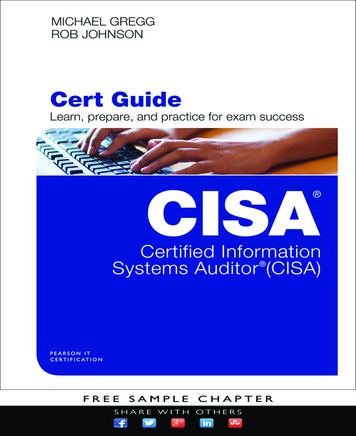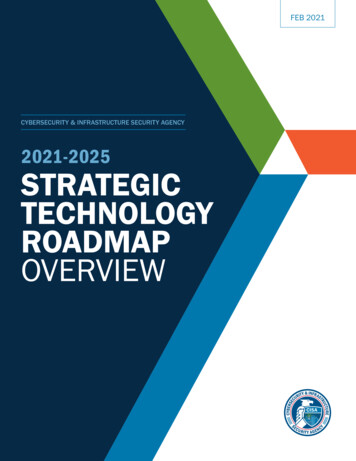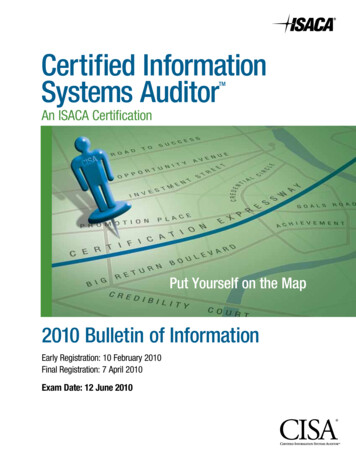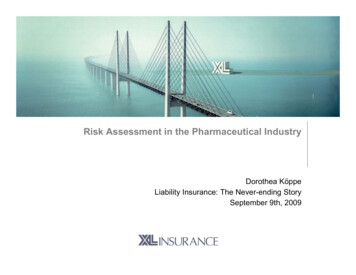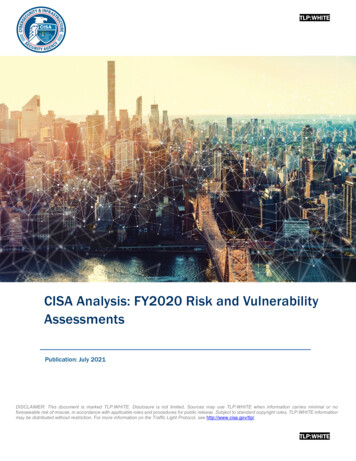
Transcription
TLP:WHITECISA Analysis: FY2020 Risk and VulnerabilityAssessmentsPublication: July 2021DISCLAIMER: This document is marked TLP:WHITE. Disclosure is not limited. Sources may use TLP:WHITE when information carries minimal or noforeseeable risk of misuse, in accordance with applicable rules and procedures for public release. Subject to standard copyright rules, TLP:WHITE informationmay be distributed without restriction. For more information on the Traffic Light Protocol, see http://www.cisa.gov/tlp/.TLP:WHITE
TLP:WHITEBACKGROUNDEach year, the Cybersecurity and Infrastructure Security Agency (CISA) conducts Risk andVulnerability Assessments (RVAs) of Federal Civilian Executive Branch (FCEB), Critical Infrastructure(CI), and State, Local, Tribal, and Territorial (SLTT) stakeholders. An RVA assesses an organization'soverall effectiveness in identifying and addressing network vulnerabilities. In Fiscal Year 2020 (FY20),CISA conducted 37 RVA assessments of multiple stakeholders across the various sectors and alignedthe results to the MITRE ATT&CK framework. The goal of the RVA analysis is to develop effectivestrategies that positively impact the security posture of FCEB, SLTT, and CI stakeholders.During an RVA, CISA collects data through onsite assessments and combines it with national threatand vulnerability information to provide an organization with actionable remediation recommendationsprioritized by risk. CISA designed RVAs to identify vulnerabilities that adversaries could exploit tocompromise network security controls. An RVA may incorporate the following methodologies: Scenario-based network penetration testingWeb application testingSocial engineering testingWireless testingConfiguration reviews of servers and databasesDetection and response capability evaluationAfter completing the RVA, CISA provides the organization a final report that includes businessexecutive recommendations, specific findings, potential mitigations, and technical attack path details.CISA’s RVA teams leverage the MITRE ATT&CK framework, which is a “globally accessibleknowledge base of adversary tactics and techniques based on real-world observations.”1 Theframework aims to build a community-driven knowledge base—comprising known tactics, techniques,and procedures (TTPs) of threat actors—to help develop threat models and facilitate vulnerabilitymitigation efforts. The framework includes 14 distinct attack paths that cyber adversaries use to obtainand maintain unauthorized access to a tices-mitre-attckr-mappingPage 2TLP:WHITE
TLP:WHITEINTRODUCTIONThis report analyzes a sample attack path that a cyber threat actor could take to compromise anorganization with weaknesses that are representative of those CISA observed in the FY20 RVAs.2 Thepath comprises six successive tactics, or "steps": Initial Access, Command and Control, LateralMovement, Privilege Escalation, Collection, and Exfiltration. In addition to this analysis, the reportincludes the following observations: Most of the successful attacks proved to be methods commonly used by threat actors,e.g., phishing, use of default credentials.The list of tools and techniques used to conduct these common attacks is ever changing.Many of the organizations exhibited the same weaknesses.Attack Path AnalysisCISA developed the following sample attack path based loosely on the ATT&CK methods used by theassessment teams and the varying success rates of each tactic and technique. Considering the mostsuccessful methods, it is reasonable to assume that a skilled threat actor may follow this path tosuccessfully exploiting its target.This path is not all-encompassing of the potential steps used by malicious actors and not all attackpaths follow this model. However, these steps serve to highlight some of the more successful attackstrategies used during RVAs and the impacts these strategies have had on a target network.The attack path begins with a step required by many real-world attacks: gaining Initial Access [TA0001].Next in the path is establishing Command and Control [TA0011]. Using the initial foothold within thenetwork, Lateral Movement [TA0008] is conducted, followed by attempts at Privilege Escalation[TA0004]. Once entrenched in the network, the focus of our path switches to the Collection [TA0009] ofsensitive data and concludes with Exfiltration [TA0010].Note: This attack path does not directly align with the techniques and methods used by the RVA teams.See Figure 1 for tactic icons used in this report.2 See https://www.cisa.gov/publication/rva for the FY20 infographic: RVAs Mapped to the MITRE ATT&CK Framework, whichbreaks out the top three most successful techniques for each tactic documented by the FY20 RVAs.Page 3TLP:WHITE
TLP:WHITEFigure 1: Tactic IconsA thorough analysis of vulnerability trends (i.e., prevalence over time, types of systems and agenciesimpacted, etc.) includes an examination of the impact the vulnerabilities have on affected systems. Thebelow attack path analysis includes an Impact section for each tactic that details the possible results ofsuccessful exploitation.Additionally–because awareness of critical vulnerabilities alone does not successfully improve securityposture—the analysis includes a Mitigation/Remediation section for each tactic, which detailsmitigations/remediations for the vulnerabilities associated with each attack strategy.Finally, to provide more context to the attack methods discussed and highlight how each tactic isenacted, the analysis includes known TTPs associated with Advanced Persistent Threat (APT) groupAPT39.3 An examination of real world, adversarial TTPs can aid vulnerability analysts in determiningthe actual effectiveness of current and future network protections and help prioritize mitigation activities.INITIAL ACCESSWHATInitial Access [TA0001] is the step during which cyber threat actors attempt to obtainunauthorized access to a victim organization’s internal network. These attacks dependon remotely positioned adversaries gaining internal access to an organization’s network.Typically involving techniques that allow some level of anonymity, access steps are oftenconducted from a “safe” distance from the target, such as the attacker’s country of origin.However, there are many instances of adversaries gaining network access through aninsider threat or from locally planted media (e.g., CD, DVD, USB) containing malware.WHYGaining initial access to an organization’s network is one of the primary goals of a threatactor in determining the success of their campaign. If initial access is establishedundetected, threat actors may have ample time to steal sensitive information, pacing3Although APT39's targeting scope is global, its activities are concentrated in the Middle East. Masked behind its frontcompany, Rana Intelligence Computing Company (Rana), the Government of Iran employed a years-long malware campaignthat targeted Iranian dissidents, journalists, and international companies in the travel sector.Page 4TLP:WHITE
TLP:WHITEthemselves to avoid triggering network detections and alarms. Preventing initial accessshould be one of the primary goal organizations establish to protect their network assetsand to keep sensitive information intact.HOWAPT39 uses a variety of custom and publicly available malware and tools at all stages ofthe attack lifecycle. APT39 has sent spearphishing emails with malicious attachments(Phishing: Spearphishing Attachment [T1566.001]) or hyperlinks (Phishing:Spearphishing Link [T1566.002]), typically resulting in a POWBAT infections. In additionto using a specific variant of the POWBAT backdoor, APT39 has primarily leveraged theSEAWEED and CACHEMONEY backdoors. APT39 also used attack techniques such asSQL Injection (Exploit Public-Facing Application [T1190]) to gain a foothold on publicfacing applications. After compromising web servers, APT39 has proceeded to installweb shells, such as ANTAK and ASPXSPY, and has used stolen, legitimate credentialsto compromise externally facing Outlook Web Access (OWA) resources (ServerSoftware Component: Web Shell [T1505.003]).RVA Attack AnalysisPhishing: While conducting assessments, the RVA team obtained initial access using phishing links[T1566.002] 49 percent of the time and phishing attachments [T1566.001] 9.8 percent of the time.Phishing is the delivery of targeted emails that often include malicious links or attachments designed toprovide the adversary an entryway into the recipient’s computer. An adversary’s phishing success ratedepends on multiple factors, such as the perceived authenticity of the email’s content and presentation,host protections (e.g., antivirus and malware detection software), and the network’s boundaryprotection mechanisms.Exploit Public-Facing Applications: Attacks on public-facing applications made up 11.8 percent ofsuccessful attempts at gaining initial entry during RVAs. This type of attack involves exploiting thevulnerabilities associated with applications that are accessible from the internet. The existence of thesevulnerabilities is typically public knowledge and, as a result, there may be several active exploits orproof of concepts (POCs) associated with them. Targets for these attacks include websites, databases,and network services (e.g., Secure Shell [SSH], Telnet, File Transfer Protocol [FTP]).Valid Accounts: The use of legitimate accounts made up 11.8 percent of successful attempts atgaining initial entry during RVAs. In many cases, gaining initial access through valid accounts is madepossible via insecure software development practices. Examples include hard-coded passwords in webapplication code, default credentials for well-known applications, and unintentional informationdisclosure of account information on public forums or open-source code repositories.ImpactSuccessful entry is often the first win achieved by a malicious actor. With internal access, attackers areprivy to private systems and information. The next step for the attack—whether it be lateral movement,mission disruption, or gaining increased privileges—may not be possible without this initial access.Mitigation/Remediation Page 5Control execution through allowed application lists.TLP:WHITE
TLP:WHITE Disable macros.Monitor the execution of Living Off the Land Binaries (LOLBins).Identify and remediate public facing vulnerabilities to help prevent initial access using aproactive patch management program.Train users to be aware of suspicious emails as well as the common indicators of socialengineering attempts.Utilize a cloud service provider for mail exchange (MX) that implements strong emailsecurity, including Domain-based Message Authentication, Reporting and Conformance(DMARC), Sender Policy Framework (SPF), DomainKeys Identified Mail (DKIM), andattachment vulnerability scanning.Used together, these technologies form a strong anti-phishing mechanism for anorganization’s mail exchange.Implement—if a cloud provider is not an option—an email technology that will:o sandbox or review email attachments for any malicious functionality, ando review email messages for malicious external links and domains.COMMAND AND CONTROL (C2)WHATAn ongoing engagement requires an attacker to maintain a foothold in a target networkfor an extended period. An attacker will attempt to create an avenue to allow themselvescontinued access to the environment at any given moment. By establishing a hiddencommunications channel between their remote servers and compromised systems withinthe target network, adversaries can conduct internal activity while avoiding detection.WHYSome adversaries require a great deal of time with exposure to the victim environment.Depending on the overall intent of a malicious campaign, attacks may span severalweeks or months. The time needed to slowly identify and collect sensitive data, or quietlydisrupt day-to-day operations, requires undetected access to target systems whileoperating from remote locations.HOWOne common method for establishing a command and control tunnel into and out of acompromised network is to send all traffic through a well-known port or protocol. APT39has used tools that communicate with common protocols—such as HTTP and DNS—that routinely pass back and forth between the internet and internal network segments.Additionally, APT39 has used tools that masquerade as legitimate applications to evadedetection of control communication. For example, applications posing as Mozilla Firefoxor McAfee components often go undetected.RVA Attack AnalysisWeb Protocols: Most of the successful attempts at establishing communication channels from withinthe assessed organization’s network utilized ports that are typically associated with standardcommunication protocols. This use of well-known ports and protocols comprised 42 percent ofsuccessful attempts at establishing C2. By using a protocol that is typically allowed through boundaryprotections, such as HTTP or DNS, the assessment teams can evade common port filtering andpotentially avoid detection.Remote Access Software: The assessment teams used remote tools (15.9 percent of successfulattempts) such as the Microsoft Windows Remote Desktop Protocol (RDP) to discretely managePage 6TLP:WHITE
TLP:WHITEinternal activity and to spread their attack footprint to neighboring systems. The use of known remotemanagement tools can allow attackers to avoid perimeter protocol filters.ImpactThe use of undetected control channels to conduct operations remotely, from anywhere in the world,allows adversaries the anonymity and stealth needed to operate on a victim network—uninterrupted—until mission objectives are achieved.Mitigation/Remediation Prevent applications from storing credential data and change default usernames andpasswords where applicable.Periodically review user and application privilege level and search for newly createdaccounts to identify unauthorized grants of elevated privilege.Configure firewalls with granular ingress and egress rules, which not only preventremote access applications from communicating outside of the network, but also allowonly protocols required by the communicating network segment to exit.Deploy signature-based intrusion detection/prevention (IDS/IPS) systems to identifymalicious communications traffic at both the network and host levels.Configure systems to prevent the installation and execution of unauthorized applications.Utilize web proxies to limit use of external web services.Implement Secure Sockets Layer (SSL) decryption for web proxies and ensure allinternet traffic flows through this mechanism.Monitor cleartext traffic for unusual activities.LATERAL MOVEMENTWHATLateral movement is the process of pivoting from host to host or from one user accountto another in order to reposition, supplement, or spread the active foothold. Theseactivities are conducted after initial access is obtained and are often used to move tonetwork locations of specific interest to the adversary.WHYMany times adversaries will gain access to compromised networks without havingproximity to the specific systems or data they are targeting. Additionally, the level ofprivilege they obtain may not be high enough to garner the access they need. For thesereasons, it is often necessary for adversaries to laterally move through the network fromhost to host or account to account until they can reach the location within the targetenvironment needed to conduct further attack steps.HOWAfter establishing a communication channel into the target network, APT39 has usedSOCKS5 proxies, RDP, and SSH to distribute remote commands throughout multiplecompromised hosts. Several of these protocols may also be used to compromise validaccounts via session hijacking. Several other well-known, built-in protocols have beenused to attack additional hosts within the target network. For example, APT39 has usedServer Message Block (SMB) to access network shares to potentially transfer andexecute malicious binaries on neighboring hosts.RVA Attack AnalysisPage 7TLP:WHITE
TLP:WHITEPass the Hash (PtH): PtH made up 29.8 percent of successful RVA attempts at lateral movement. Thistechnique bypasses the step of supplying account passwords by submitting the password hashes to theauthentication process. PtH may provide adversaries authenticated access to systems withoutdiscovering the compromised user account’s password.Remote Desktop Protocol (RDP): The use of RDP (25 percent of successful attempts at lateralmovement) allowed the assessment teams to expand their footprint within compromised networks byremotely accessing and controlling neighboring hosts from previously exploited systems.Exploitation of Remote Services: Remote services exhibiting coding errors were exploited from withinthe compromised network (11.9 percent of successful attempts at lateral movement). In some cases,the privilege level of the exploited service is higher than that of the adversary. Exploiting remoteservices with heightened privileges may result in increased privilege levels on the newly compromisedsystem.ImpactMany organizations’ networks house systems or data deemed critical to achieving overall missionsuccess. These systems are typically located in network segments with increased protections andaccess is typically restricted based on user roles and privilege level. However, by allowing an adversaryto pivot from host to host within a compromised environment, it is possible for these critical systems tobecome susceptible to compromise. Limiting an adversary's lateral movement constrains their activityto a confined space, potentially preventing their ability to meet their target objectives.Mitigation/Remediation Limit credential overlap across systems (e.g., Windows Local Administrator PasswordSolution).Ensure sensitive data is not on share files by running monthly scans for password filesor config files with similar data.Do not allow a domain user to be in the local administrator group on multiple systems.Apply appropriate Windows patches and configurations (e.g., Pass the Hash Mitigations:Apply User Access Control (UAC) restrictions to local accounts on network logons).Use multifactor authentication (MFA) for remote management sessions.Disable the RDP service if it is unnecessary.Routinely review the list of users with remote management privileges and removeunnecessary accounts.Limit use of remote services.Use application isolation and sandboxing techniques to increase network segmentation,limiting unauthorized movement.Use host-based firewall rules to limit host-to-host traffic to required protocol andservices.PRIVILEGE ESCALATIONWHATPage 8The level of initial access acquired by cyber threat actors is often limited. To ensuresuccessful exploitation and compromise, malicious actors often attempt to increase theprivilege level being used prior to conducting internal attacks.TLP:WHITE
TLP:WHITEWHYMany of the methods threat actors use to gain initial entry aim to obtain basic useraccess. For this reason, attackers may begin internal activities with basic user accessand seek to escalate their privilege level. Maintaining proper authentication andauthorization standards would limit user access to sensitive data, networks segments,and controls. Without control of privileged, administrative, or Root/SYSTEM accounts,adversarial attacks may not succeed.HOWAfter the initial foothold has been established, APT39 typically utilizes freely availabletools, such as Mimikatz and Ncrack, in addition to legitimate tools, such as WindowsCredential Editor and ProcDump, for privilege escalation. APT39 often uses these toolsin conjunction with system-level privileges to gain access to enterprise-level accountssuch as a Domain Administrator account.RVA Attack AnalysisValid Accounts: The assessment teams were able to escalate their level of privileged access duringmany of the RVA assessments conducted in 2020. The use of legitimate accounts made up the largestportion (37.5 percent) of the successful tactics used. Use of valid accounts can be achieved throughvarious means including hard coded credentials, default credentials, or guessed passwords fromoperating system hash dumps.Exploitation for Privilege Escalation: The assessment teams used exploitation techniques on 21.9percent of their successful attempts at privilege escalation. This form of escalation takes advantage ofsystem or software vulnerabilities that specifically lead to an increased level of user privilege. Anexample of this type of attack would be to trick a vulnerable application into creating an account for theattacker and granting them elevated privileges.Token Impersonation: The teams used copies of existing security tokens for 15.6 percent ofsuccessful RVA escalation techniques. Using tokens from existing system-level processes, and thenattaching these tokens to malicious processes, allows a threat actor to run their code with increasedprivileges; potentially providing more access and control than administrator accounts (e.g., DomainAdministrator).ImpactSuccessful privilege escalation grants unauthorized, privileged access to sensitive data, systems, orprocesses. Even with internal access, attackers with limited privileges may be restricted from carryingout actions with critically severe results. However, having Domain Administrator access, for example,could allow a threat actor to impair mission critical functions that could potentially lead to the loss ofequipment or resources.Mitigation/Remediation Page 9Update software applications regularly.Exercise least privilege when creating and managing accounts.Limit users’ permissions to create tokens.Prevent write access to logon scripts and prevent modification ofassociated registry keys.Utilize sandboxes and application micro segmentation where applicableTLP:WHITE
TLP:WHITE to limit adversarial movement and exposure.Prevent applications from storing credential data and change defaultusername and password where applicable.Periodically review user and application privilege level and search fornewly created accounts to identify unauthorized grants of elevatedprivilege.Perform password file searches on all shares and local drives.Configure applications with security best practice standards (e.g., disablexp cmdshell on MS SQL Databases).Utilize a strong password policy to prevent password hashes from beingeasily guessed.COLLECTIONWHATAfter achieving a presence within an organizations network, collection of sensitiveinternal data is often one of the primary goals of an attacker. Attempts to pull this datafrom within the compromised network using C2 channels may be the next steps in theirattack plan.WHYAPT39's significant targeting of the telecommunications and travel industries reflectsefforts to collect personal information on targets of interest and customer data for thepurposes of surveillance and to facilitate future operations. Telecommunications firmsare attractive targets given that they store large amounts of personnel and customerinformation, provide access to critical infrastructure used for communications, andenable access to a wide range of potential targets across multiple verticals.HOWUndetected adversaries with an internal foothold and elevated privileges may haveaccess to file systems and directories containing sensitive information, as well asnetwork shares with access typically limited to specific users (e.g. Admin Shares).APT39 has used the tool CrackMapExec to enumerate network shares searching forstores of sensitive data. Once found, APT39 has used tools such as 7-zip and WinRARto create data archives.RVA Attack AnalysisData from Local System: Sensitive information identified by the assessment teams was foundprimarily on local systems. This sensitive information accounted for 32.2 percent of successful attemptsat locating sensitive data. Local file systems and databases are typical sources of local data.Data from Network Share Drive: The RVA reports revealed that data on shared drives constituted30.5 percent of successful data access attempts. Network shares are often used to segment data forrole-based access, such as Admin shares. Remotely accessing network shares is not a finding itself.The weakness exhibited here exists when users who should not be permitted to view specific data aregranted access to shares due to misconfigured permissions.ImpactAllowing adversaries to locate and collect sensitive data negates the intended function of networksecurity, communication security, operation security, and physical security efforts.Page 10TLP:WHITE
TLP:WHITEMitigation/Remediation Unfortunately, data collection cannot be directly remediated. Any activity conductedduring collection uses existing system features such as operating system directorystructure or database queries. For this reason, it is critical that defenses areimplemented to limit the effectiveness of the attack phases leading up to and followingdata collection.Effective network monitoring will aid in the detection of collection efforts. Use of honeytokens or honey files will alert network defenders of malicious collection attempts.Deploy data loss prevention (DLP) tools to detect and alert on unauthorized data access.EXFILTRATIONWHATSome adversaries target sensitive information, such as blueprints, security requirementsdocuments, or vulnerability information from a compromised system or enclave.WHYMany adversaries conduct attacks to gain access to information such as building plans,IP ranges, software versions, and hardware lists. By removing this data, adversariesmay be able to analyze organizational information from the safety of their remotelocation. Even if their activity is detected by the compromised agency and theircampaign is ended, the stolen data is still available to the attacker for later use.HOWUsing either existing C2 channels or hidden within traffic flowing through common portsand protocols–such as HTTPS–attackers can package and send data to varioussystems on the internet. APT39 has also used the legitimate web service DropBox toconduct C2 for uploading and downloading stolen files and malicious code.RVA Attack AnalysisExfiltration over C2 Channel: 68.2 percent of successful exfiltration attempts by the assessmentteams was conducted through C2 channels. Using the same channels previously established forremote access allowed the teams to download information without the need for establishing additionalpathways and potentially alerting network defenders.ImpactThe analysis of stolen information may lead to the recreation of blueprinted technologies, targeting ofsupply chain components, or public release of information to achieve other sociopolitical objectives.Mitigation/Remediation Deploy network IDS/IPS to alert or stop network traffic associated with known malware.At the network boundaries, IDS and IPS protections use signature-based analysis todetermine if traffic is malicious.Implement SSL decryption for web proxies and ensure all internet traffic flows throughthis mechanism. Monitor cleartext traffic for unusual activities.Deploy data loss prevention (DLP) tools to detect and provide alerts onunauthorized data removal.CONCLUSIONPage 11TLP:WHITE
TLP:WHITEAfter conducting trend analysis on the 37 RVA reports executed by CISA, several high-levelobservations were identified. Methods such as phishing and the use of default credentials were stillviable attacks. This shows that the methodologies used to compromise much of our infrastructure havenot changed drastically over time. As a result, network defenders must refocus their efforts at deployingthe myriad of mitigation steps already known to be effective.Unfortunately, the list of tools and techniques used to conduct well-known attacks is constantlyevolving. For this reason, network defenders much remain vigilant in understanding and observing thesignatures of new TTPs. An additional observation is that for several MITRE categories, manyorganizations exhibited the same weaknesses. Threat actors, with capability and intent, may besuccessful at compromising many agencies across multiple sectors. Conversely, the benefit of thistrend is that the high-level mitigation recommendations made by CISA may apply to manyorganizations. However, individual organizations will need to tailor fix guidance to fit their specificnetwork architectures while dealing with their specific resource constraints. CISA strongly recommendssystem owners and administrators convey this guidance to their leadership and apply changes relevantto the nuances of their specific environments.Finally, CISA concludes that analysis of this nature may help network defenders—across multiplesectors and organizations—effectively prioritize the identification and mitigation of high-levelvulnerabilities. CISA intends for future iterations of this effort to incorporate the specific TTPs used bythe assessment teams, which should facilitate a more thorough analysis and potentially improvemitigation recommendations.REFERENCES CISA Cyber Resource Hub. https://www.cisa.gov/cyber-resource-hub.CISA RVA webpage. https://www.cisa.gov/publication/rva.MITRE ATT&CK. https://attack.mitre.org.MITRE ATT&CK v9.0, Enterprise Tactics. prise/.The MITRE Corporation (2015), APT 39. https://attack.mitre.org/groups/G0087/.National Institute of Standards and Technology, National Vulnerability Database.https://nvd.nist.gov.Page 12TLP:WHITE
Used together, these technologies form a strong anti-phishing mechanism for an organization’s mail exchange. Implement—if a cloud provider is not an option—an email technology that will: o sandbox or review email attachments for any malicious functionality, and o review
